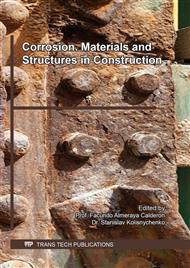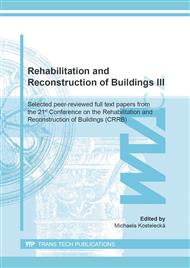p.3
p.10
p.15
p.24
p.32
p.39
p.45
p.51
Determining Criteria for Assessment of RC Structures Affected by Carbonation-Induced Corrosion
Abstract:
The construction industry is now facing expanding and extensive activities in the area of assessing and retrofitting buildings and bridges that aligns with the sustainable construction strategy. These activities recognise the importance of extending the life of existing construction works thereby delivering environmental, economic and socio-political benefits. Reinforced concrete structures and their reliability are currently receiving considerable attention as a significant part of these structures reaches the design service life. Degradation processes such as carbonation- and chloride-induced corrosion have a major influence on the reliability and serviceability of concrete structures. The submitted study is primarily focused on reinforced concrete structures whose main degradation factor is carbonation of the concrete cover. Examples of such structures are cooling towers or industrial chimneys. Structures in the power industry are usually designed for service life of 40 years. Carbonation-induced corrosion results in visible cracks and unacceptable spalling of concrete cover. The aim of the study is to improve predictions of carbonation-induced corrosion propagation and to critically compare the criteria for degradation level assessment used in practice. The probabilistic analysis is based on measurements of concrete cover and carbonation depths and continuous observations of signs of corrosion on structural surfaces. The example of an industrial chimney shows that the limit of a severe failure, which requires (possibly repeated) minor repairs, is exceeded after about 17 years. The critical failure limit (30% of structural surface with visible signs of corrosion) is reached after 50 years, which seems to be sufficient as it is after 10 years than the usual design service life.
Info:
Periodical:
Pages:
3-9
Citation:
Online since:
October 2020
Authors:
Keywords:
Price:
Сopyright:
© 2020 Trans Tech Publications Ltd. All Rights Reserved
Share:
Citation:



